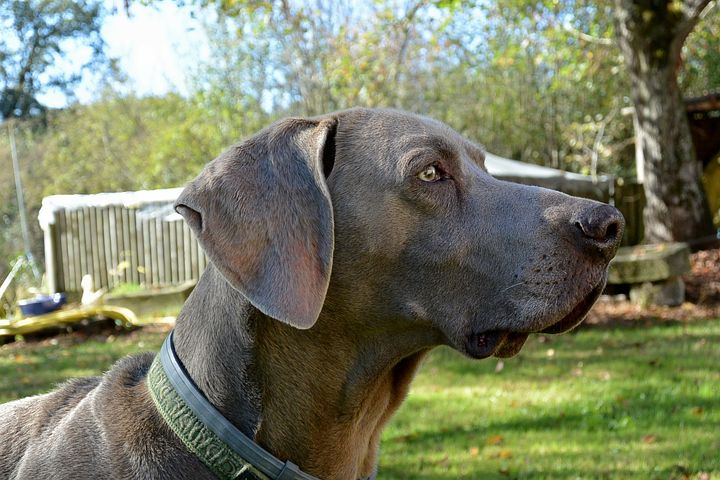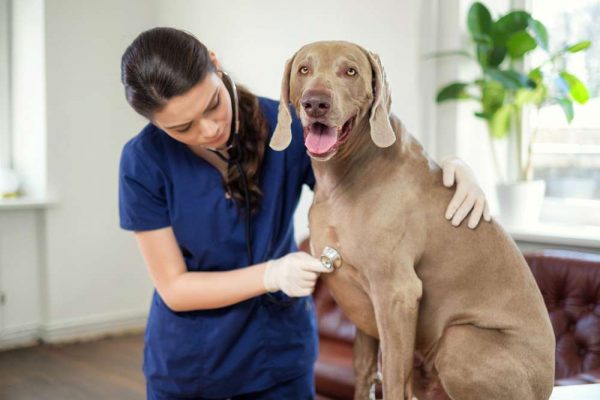Canine influenza has symptoms similar to several other diseases in dogs. New to veterinary medicine, dog flu comes in two forms, and, under the right circumstances, it spreads quite easily.
Knowing what the symptoms of canine influenza are, how it spreads, and how to avoid exposing your dog, can help you prevent infection in your Weimaraner.
- What is dog flu?
- Where did canine flu come from?
- How do dogs get canine influenza?
- Be alert for these dog flu symptoms…
- How serious is canine influenza?
- Treatment for Dog Flu
- Should you consider a dog flu vaccine?
- Can you get dog flu from your dog?
- Why the CDC is concerned about dog flu

What is canine influenza?
Dog flu or canine influenza is a type A flu virus, which is the type virus that affects dogs. Viruses are classified, using letters and numerals. And there are type A and type B viruses.
The term “dog flu” is currently used to describe two different canine viruses, the H3N8 virus and the H3N2 virus. This is different from just a few years ago, when the only known dog flu virus was H3N8.
These canine flu viruses attack the respiratory system in dogs, and they are very contagious.
Where did canine flu come from?
H3N8 Horse Flu Virus
The original dog flu virus was first seen horses (H3N8), and it was known as equine influenza or Horse Flu. We saw this virus in horses for over 40 years before it jumped species and started to infect dogs.
In 2004 working greyhound dogs in the United States started getting a respiratory infection that had not been seen before. Veterinarians discovered that the greyhound dogs were getting horse flu or equine influenza.
Researchers at Cornell’s Animal Health Diagnostic Center isolated the virus at that time. And they believe that the H3N8 horse flu virus jumped from horses to the racing greyhound dogs.
However, there was a new development in September of 2005. Scientists discovered that the virus dogs were getting was a new pathogen, a dog-specific version of the H3N8 horse flu virus.
The Centers for Disease Control (CDC) determined that the virus was definitely related to the equine flu virus (H3N8) that was circulating and infecting horses in the U.S. But the new version was dog-specific.
The H3N8 virus is now infecting dogs in many different U.S. regions.
H3N2 Bird Flu Virus
The second type of dog flu virus comes from the H3N2 avian flu virus, better known as Bird Flu. This virus has also mutated and started to infect dogs. This mutation is more recent than the H3N8 virus mutation. You may remember that we had a scare (and fear of a pandemic) with a form of Bird Flu (H1N1) in people in 2007.
The H3N2 dog flu virus is a new form of the virus that is specific to dogs, although it has occasionally infected cats.
You may know that humans get an H3N2 flu virus during the flu season. This is a different version of the virus, not exactly the same virus as the H3N2 dog flu virus.
So are these viruses just seen in the U.S.? Not really. Dogs in South Korea started getting the H3N2 dog flu virus in 2007, and dogs in Thailand and China have also become infected.
In the U.S., we first saw this version of canine influenza in Chicago, in April 2015. How it got to the U.S. remains a mystery.
How do dogs get canine influenza?
Both versions of canine influenza are very contagious. It is very easy for one dog to catch it from another. And the H3N8 Horse Flu virus can live on different surfaces for up to 48 hours and on your hands for up to 12 hours.
On the other hand, the Bird Flu virus, H3N2 does not survive very long outside a dog’s body. Dogs catch it from each other by direct contact or being close to each other.
While it is a little more difficult to catch, the H3N2 virus makes dogs sick more easily. It also can shed (a word we use to describe spreading a virus) from one dog to another for more than 20 days after a dog has been exposed.
A dog may not even be sick yet, but he can infect other dogs.
How Do Dogs Spread Dog Flu?
Here are some of the ways that dogs can give it to each other:
- Nose to nose contact with a sick dog’s runny nose
- Drinking or eating from a sick dog’s bowls
- Playing with a contaminated dog toy
- Sniffing or licking contaminated objects like dog bedding, collar, leash
- Sniffing or licking another dog’s poop
- People can infect dogs by carrying the virus on their clothing or hands. Always wash your hands thoroughly between touching dogs.
As you can see, normal dog behavior spreads the virus.
The dogs most likely to get the dog flu are those who are in a shelter, day care, boarding kennel or those who spend time at a dog park playing with other dogs. Even dogs who live together can spread it to each other.
Additionally, dogs who go to the veterinarian where there are dogs with flu, to dog shows or to a dog-friendly business like PetSmart can come into contact with the virus.
In other words, dogs who are in contact with multiple other dogs are the most likely candidates to get dog flu.
If you have a kennel, volunteer at a dog shelter or breed dogs and have an outbreak of the flu, this could end up being a nightmare for you.
You will need to make sure that clothing, equipment, dog bowls, dog toys, etc. are all disinfected after they are exposed to a sick dog. And you need to assume that any dog could be getting sick.
It is especially important that you wash your hands frequently. Even things like your computer mouse, your shoes, and light switches can be a source of the virus for hours or a few days.
Dog flu symptoms to watch for
So how do you know if a dog is coming down with the flu?
The most common symptom of canine flu is a cough. The cough lasts anywhere from 10-30 days. Because of the cough, dog flu is often initially confused with kennel cough.
Unfortunately, dogs have no natural immunity for either of the two types of canine flu.
These are the most common symptoms that you might see:
- Cough – the most obvious symptom. This might be the first one that you notice.
- Runny nose – Clear at first, then turning to thick, yellow-green mucus.
- Fever – Mild or low grade, 103 F or higher. This is quick and easy to check if you have a dog thermometer. Look for a surface thermometer that does not have to be inserted into the anus.
- Eye discharge
- Lethargy – slow to move, not doing very much. No energy or enthusiasm for activities your dog usually enjoys.
- Not eating
The symptoms of dog flu also resemble heart disease or even cancer. So if your dog shows symptoms, he should probably be checked by a professional.
Your vet is able to do a test that will determine, for sure, whether your dog has canine influenza.
How serious is canine influenza?
Like many things in life, these viruses follow the 80:20 rule. Most dogs (80%) who get dog influenza will get a mild case. They will recover within 2-3 weeks. You may not even see the symptoms, and your dog will get well without your knowing that she had the flu.
However, some dogs can get severely ill. Usually these dogs have gone into pneumonia and they are very sick.
A small percentage of dogs who get this ill with the flu, will die.
Treatment for Dog Flu
If your Weimaraner gets dog influenza, there are a few common sense things that you can do to help him:
Water
Make sure he has plenty of water and stays hydrated. This helps keep his fever down and also helps to move toxins and dead virus cells out of his body.
Immunity
Help strengthen your dog’s immunity. Because your dog is weak when sick, a supplement to strengthen immunity can help her get stronger and well.
Chelated Silver
Chelated silver has been tested and found to eliminate viruses, bacteria and funguses in both people and animals. It is safe and natural, and it works specifically on respiratory infections, among other conditions.
Cough suppressants
These can help, if the coughing is severe. This homeopathic cough suppressant can help keep your dog comfortable and help both of you sleep at night.
Antibiotics
Prescribed for dogs who develop secondary infections like pneumonia. Your vet will need to prescribe any antibiotics.
Dogs who are severely ill, may be hospitalized for intensive care. They will probably have intravenous fluids, antibiotics and possibly be given oxygen. A small percentage of these very ill dogs will not survive.
Should you consider a dog flu vaccine?
Vaccines have been developed for both the H3N8 and H3N2 strains of dog flu. It’s hard to tell if the vaccines are safe and effective, since they have only been developed recently.
Vaccinations are given for both types of dog flu and they are given 2-4 weeks apart. After that, your dog will be given annual boosters.
If your Weinheimer is old or if she has had a reaction to a vaccine before, you should consider carefully whether giving her another vaccine is worth risking the possible side effects.
Can you get dog flu from your dog?
It sounds like you can pass the viruses back and forth between you and your dog. However, so far, dog flu has not proven to be zoonotic (infecting both animals and humans).
So, at this time, there is no evidence that either virus can be passed back and forth between humans and dogs. After the viruses mutated, they became totally new forms of the viruses–and the new (dog) viruses do not affect people. Just dogs.
Why is the CDC concerned about dog flu?
Viruses can change, and they do so frequently. Because it is possible for the dog flu virus to evolve, so that it could infect people, the CDC (Centers for Disease Control) in the U.S., is monitoring the virus closely.
Here’s the reason. Since humans have no immunity to a dog virus, we could see a pandemic or people could become really ill if the virus mutates into a virus that affects people again.
However, currently, neither the H3N8 nor the H3N2 flu viruses is a concern for people. You can’t get the dog flu from a dog at this time.






Leave a Reply